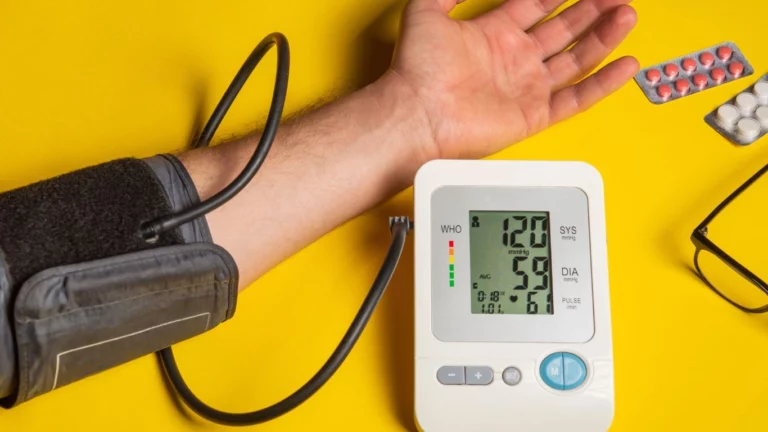The Hidden Dangers of Air Pollution on Your Blood Pressure
As someone who’s been working in the field of hypertension for quite some time, I can tell you that the links between air pollution and blood pressure are much stronger than we might have realized even a few years ago. It’s something I’ve noticed in my practice as more patients mention issues with air quality affecting their health, particularly their blood pressure. If you’re living in an area with high pollution levels, the effects on your cardiovascular health could be subtle at first, but over time, they can be quite profound. In this article, we’ll dive into how air pollution can impact blood pressure, and what you can do to protect yourself.
The Growing Concern: How Air Pollution Affects Your Blood Pressure
For years, we’ve known that air pollution can have devastating effects on lung health, but its impact on cardiovascular health has been somewhat of a hidden story. In my experience, more patients are coming in with questions about the environment’s effect on their health—especially those living in cities with poor air quality. Research is now showing that air pollution can have a significant effect on your blood pressure, contributing to chronic hypertension and increasing the risk of heart disease.

What Exactly Is Air Pollution?
Air pollution is a mix of harmful substances in the air, including particulate matter (PM), ground-level ozone, carbon monoxide, and nitrogen dioxide. These pollutants come from a variety of sources, from traffic emissions to industrial waste, and they can significantly degrade the quality of the air we breathe. It’s no secret that cities are usually the hotspots for high levels of pollution, but even suburban or rural areas can have their own issues, especially when nearby industries are releasing toxic emissions into the atmosphere.
But here’s the thing that’s often overlooked: Air pollution isn’t just about the dirty air you see—it’s about the tiny particles that are invisible to the naked eye, the microscopic pollutants that can infiltrate your lungs and enter your bloodstream. It’s these tiny particles, known as particulate matter (PM2.5), that are responsible for much of the damage to your cardiovascular system.
How Does Air Pollution Affect Blood Pressure?
Now, let’s break it down: When you breathe in polluted air, these particles and gases don’t just stay in your lungs—they can enter your bloodstream and travel throughout your body. That’s when things get tricky. Studies have found that long-term exposure to air pollution can lead to an increase in blood pressure. This is especially true for the fine particulate matter (PM2.5), which has been shown to trigger inflammation and oxidative stress, both of which are known to contribute to high blood pressure.
Imagine this scenario: you’re living in a city with high levels of air pollution, and over time, your blood vessels are constantly exposed to harmful particles. This can cause your blood vessels to become stiffer, which makes it harder for blood to flow smoothly. As a result, your heart has to work harder to pump blood, which leads to an increase in blood pressure. This is why people living in high-pollution areas are often at a higher risk for developing hypertension.

The Role of Inflammation and Oxidative Stress
If you’ve been reading up on hypertension or heart health, you’ve probably heard the terms inflammation and oxidative stress thrown around a lot. They’re big players in the story of how air pollution can mess with your blood pressure. Here’s why:
- Inflammation: When your body senses something harmful—like the particles from air pollution—it mounts an inflammatory response to protect itself. While short-term inflammation is your body’s way of defending itself, chronic inflammation is a different beast. Over time, it can damage your blood vessels and increase your blood pressure.
- Oxidative Stress: This happens when there’s an imbalance between free radicals (unstable molecules) and antioxidants (which neutralize free radicals). Air pollution contributes to the creation of free radicals in the body, leading to oxidative stress. This imbalance damages cells and tissues, including those in your blood vessels, contributing to high blood pressure.
From my experience, many people don’t realize just how much these environmental factors are influencing their health until it’s too late. It’s only when I explain this connection to my patients that they start connecting the dots between their environment and their health issues.
Which Pollutants Are the Biggest Culprits?
There’s no shortage of harmful substances in the air, but a few pollutants stand out when it comes to their effect on blood pressure:
- Particulate Matter (PM2.5): These are tiny particles that are less than 2.5 micrometers in diameter, so they can easily penetrate deep into your lungs and even enter your bloodstream. Long-term exposure to PM2.5 is linked to an increased risk of hypertension and other cardiovascular diseases.
- Nitrogen Dioxide (NO2): Often a byproduct of vehicle emissions and industrial activity, NO2 has been shown to have a direct impact on blood pressure. It can also contribute to inflammation in the lungs and blood vessels.
- Ground-level Ozone (O3): While ozone high up in the atmosphere protects us from the sun’s harmful rays, ground-level ozone is a different story. This pollutant is known to damage the respiratory system and has been shown to contribute to elevated blood pressure, especially in urban areas.

Who’s at Higher Risk?
Not everyone is equally affected by air pollution, but certain groups are at a higher risk of developing hypertension or suffering more severe effects from it. These groups include:
- People living in areas with consistently high levels of pollution (think busy cities with heavy traffic).
- The elderly, whose cardiovascular systems may already be weakened by age.
- People with preexisting conditions, like asthma, COPD, or obesity, which can amplify the effects of air pollution on blood pressure.
- Children, whose lungs and cardiovascular systems are still developing and may be more susceptible to environmental stressors.
Having been in this field for so long, I’ve seen firsthand how those in these higher-risk categories experience more significant health problems, often without even realizing that air pollution could be a contributing factor.
How Long-Term Exposure to Air Pollution Can Increase Your Blood Pressure
If you’re wondering just how long it takes for air pollution to affect your blood pressure, the truth is it can happen more quickly than you might think. In my practice, I’ve seen patients who have lived in areas with high levels of pollution for years, and they often start experiencing changes in their blood pressure well before they even realize the connection. The longer you’re exposed to harmful pollutants, the greater the risk of developing high blood pressure, or worsening existing hypertension.

The Chronic Effects of Air Pollution
Over time, constant exposure to pollution puts a strain on your cardiovascular system. Your blood vessels can become inflamed, leading to a condition called endothelial dysfunction. This is when the inner lining of your blood vessels doesn’t function properly, making it harder for blood to flow freely. This increase in resistance makes your heart work harder to pump blood, leading to higher blood pressure. It’s not just about feeling a little out of breath or noticing your eyes water anymore—this is the beginning of a long-term problem that can put you at risk for stroke, heart attacks, and kidney disease.
In my experience, people don’t always realize that it’s not just the occasional spike in blood pressure that’s concerning—it’s the cumulative damage over time. Even slight increases in blood pressure, when sustained over years, can have serious long-term effects on your health. Air pollution accelerates that process, particularly for those who live in cities or near industrial zones.
What Happens to Your Body When You’re Exposed to Air Pollution?
To really understand how air pollution messes with your blood pressure, let’s take a closer look at what happens to your body when you breathe in polluted air. When you inhale fine particulate matter, it doesn’t just stay in your lungs—it makes its way into your bloodstream. From there, it can wreak havoc in various parts of your body, including your heart and blood vessels.
- Increased heart rate: When your blood vessels become constricted and inflamed due to pollution, your heart works harder to pump blood, leading to an elevated heart rate.
- Elevated blood pressure: As your blood vessels tighten and become less flexible, your blood pressure rises. Over time, this can lead to chronic hypertension.
- Increased inflammation: Pollution is known to trigger a systemic inflammatory response in the body, which contributes to higher blood pressure and other cardiovascular diseases.
- Oxidative damage: Free radicals from pollution cause oxidative stress, damaging cells and tissues in your blood vessels, which further raises blood pressure.
When I explain this process to my patients, many are shocked at how something as seemingly invisible as air pollution can have such a big impact on their health. It’s not just about what you can see—it’s about what you can’t. And if you’ve been living in a polluted area for years, it’s worth talking to your doctor about your blood pressure levels and getting regular checkups.

How to Minimize the Effects of Air Pollution on Your Blood Pressure
So, what can you do about it? Well, there’s no magic pill to reverse the effects of air pollution, but there are a few strategies that can help protect your health. From my perspective as a hypertension expert, the key is being proactive. Whether you’re in an area with high pollution levels or you simply want to be aware of how environmental factors can affect your blood pressure, there are steps you can take to reduce your exposure and protect your cardiovascular health.
1. Limit Your Exposure to Polluted Areas
If you live in a city or area with high levels of air pollution, try to limit your time outdoors, especially during peak pollution hours. You’ve probably noticed that the air feels worse during certain times of day—typically when traffic is at its peak. If you can, try to avoid going out when pollution levels are highest, such as in the early morning or late afternoon when traffic congestion is at its worst.
When I’m advising my patients, I recommend checking local air quality indexes regularly. Many apps and websites track pollution levels in real-time, so you can plan your day accordingly. If it’s particularly bad, consider staying indoors or using air purifiers to improve air quality inside your home. Indoor air quality can be just as important as outdoor quality when it comes to your health!
2. Create a Healthier Living Environment
Speaking of air purifiers, improving the air inside your home can make a big difference, especially if you live in a high-pollution area. I always encourage my patients to invest in a good air purifier that can filter out harmful particles from the air. Plants can also help improve indoor air quality by naturally absorbing pollutants—so don’t be afraid to fill your home with some greenery!
Additionally, be mindful of the products you use at home. Many cleaning supplies and even some candles can release harmful chemicals into the air, adding to your exposure. Choosing non-toxic products can help reduce the amount of indoor air pollution.

3. Keep Active (Indoors or on Good Air Quality Days)
Exercise is a crucial part of managing high blood pressure, and it’s especially important when you’re trying to combat the effects of pollution. However, if the air quality is poor, I recommend indoor workouts like yoga, pilates, or strength training. When the air is clear, getting outside for a walk, run, or bike ride can help improve your circulation and lower your blood pressure.
Exercise helps keep your blood pressure in check by improving the health of your blood vessels, reducing inflammation, and promoting good heart health. So, make sure to stay active, but be mindful of the environmental factors that might interfere with your health.
4. Eat a Heart-Healthy Diet
It’s not just about avoiding pollution—it’s also about supporting your body with the right nutrition. A heart-healthy diet rich in fruits, vegetables, whole grains, and lean proteins can help your body better handle the stress caused by air pollution. Foods that are high in antioxidants, such as berries, dark leafy greens, and nuts, can help fight oxidative stress and reduce inflammation.
In my experience, many patients who take the time to focus on their diet experience a noticeable improvement in their blood pressure levels, even when they can’t escape environmental factors like pollution.
Case Studies & Real-Life Examples
When I talk to my patients about the connection between air pollution and hypertension, I often share real-life examples to make the issue feel more relatable. The science behind it is important, but sometimes, seeing how it plays out in actual cases can make it hit home. Let me share a couple of stories from my own practice that really emphasize how serious the impact of air pollution can be on blood pressure.
Case 1: Maria, A Long-Time City Dweller
Maria is a 52-year-old woman who has lived in the heart of a bustling city for most of her life. Over the past few years, she had been dealing with progressively higher blood pressure readings, but she never made the connection between her environment and her health issues. She came to see me about a year ago, mentioning that her blood pressure had been creeping up, despite her relatively healthy lifestyle—she didn’t smoke, exercised regularly, and ate well. After discussing her history in more detail, it became clear that Maria had been living in an area with high levels of traffic pollution for decades.
We ran some tests, and sure enough, her blood pressure was elevated, and we found signs of oxidative stress in her cardiovascular system. I explained to her how long-term exposure to pollutants like particulate matter and nitrogen dioxide could have been slowly raising her blood pressure. We began a treatment plan to help manage her hypertension, including medication, lifestyle changes, and strategies to minimize her exposure to pollution. She started using an air purifier in her home and took more precautions when going outside during peak pollution times. Over the next few months, we saw a noticeable improvement in her blood pressure levels.
Case 2: Daniel, The Outdoor Worker
Daniel, a 39-year-old construction worker, came to me with a surprising complaint—he was struggling to control his blood pressure, even though he was young and active. After examining his lifestyle, I learned that Daniel worked outdoors in an area with high levels of industrial pollution. His job required him to be exposed to the elements all day long, and despite his best efforts to stay fit, his blood pressure was still unusually high.
In Daniel’s case, the combination of long-term exposure to air pollution and physical stress from his demanding job created a perfect storm for hypertension. I recommended that he wear a high-quality mask designed to filter out fine particulate matter while at work. We also made adjustments to his diet, adding more anti-inflammatory foods to help combat the damage caused by pollution. With these changes, along with medication, Daniel was able to bring his blood pressure down significantly and maintain a healthier lifestyle.

Key Takeaways: What You Need to Remember
After exploring the science, real-life examples, and the practical steps you can take to protect yourself from air pollution’s effects on blood pressure, here are some key takeaways:
- Air pollution is a significant risk factor for high blood pressure. It’s not just about what’s visible—it’s the invisible particles in the air, like PM2.5, that can gradually damage your cardiovascular system.
- Long-term exposure matters. The more years you spend in areas with high pollution, the greater the cumulative effect on your blood pressure. Even slight increases in blood pressure, over time, can add up and lead to chronic hypertension.
- Protecting yourself from pollution is possible. You don’t have to just accept that pollution will inevitably hurt your health. Use air purifiers, limit your time outdoors during high-pollution hours, and make sure you’re taking care of your heart with regular exercise and a healthy diet.
- Individual risk factors make a difference. Some people are more vulnerable to the effects of air pollution, including those with preexisting conditions, the elderly, and children. Understanding your personal risk level is key to taking action.
FAQs
1. Can air pollution cause hypertension in healthy individuals?
Yes, air pollution can contribute to the development of hypertension even in individuals who don’t have other health issues. Long-term exposure to pollutants like particulate matter can increase inflammation and oxidative stress, which can raise blood pressure over time.
2. How can I know if air pollution is affecting my blood pressure?
If you live in a polluted area and notice that your blood pressure readings are consistently higher than normal, it’s worth talking to your doctor. Regular monitoring of your blood pressure is essential, especially if you live in an area with high pollution levels.
3. What are the best ways to reduce exposure to air pollution?
To minimize exposure, avoid outdoor activities during times of high pollution, such as early mornings or late afternoons. Use air purifiers at home, and if possible, wear protective masks when you’re outdoors in polluted areas. Additionally, staying indoors on high-pollution days and choosing air-friendly transportation options (like cycling or electric vehicles) can help reduce your exposure.
4. Is there any medication to help reduce the impact of pollution on my blood pressure?
While there isn’t a specific medication for air pollution exposure, managing high blood pressure through lifestyle changes, medications prescribed by your doctor, and reducing pollution exposure can all help lower the risk of hypertension-related complications.
Bonus: Additional Resources or DIY Tips
Here are some simple ways to further reduce your exposure to harmful pollutants:
- Indoor plants: Certain indoor plants, such as spider plants, peace lilies, and snake plants, can help purify the air inside your home. They absorb harmful chemicals and increase oxygen levels.
- Essential oils: Diffusing essential oils like eucalyptus and lavender can help improve air quality in your home and promote relaxation, which can also benefit your blood pressure.
- Stay hydrated: Drinking plenty of water helps flush toxins from your body and supports overall cardiovascular health.
Appendix: Table, References, Disclaimer, and Call to Action
While this article provides valuable insights into the effects of air pollution on blood pressure, remember that everyone’s health situation is different. It’s always best to consult with a healthcare professional to assess your specific risks and develop a personalized plan. You can refer to trusted sources for more in-depth research on the topic:
Disclaimer: This article is for informational purposes only and should not be considered as medical advice. Always consult with a healthcare provider for any concerns about your blood pressure or health.
Call to Action: If you’ve found this article helpful, share it with others who might be affected by air pollution or high blood pressure. Let’s work together to raise awareness and take proactive steps to protect our health!

Dr. Gwenna Aazee is a board-certified Internal Medicine Physician with a special focus on hypertension management, chronic disease prevention, and patient education. With years of experience in both clinical practice and medical writing, she’s passionate about turning evidence-based medicine into accessible, actionable advice. Through her work at Healthusias.com, Dr. Aazee empowers readers to take charge of their health with confidence and clarity. Off the clock, she enjoys deep dives into nutrition research, long walks with her rescue pup, and simplifying medical jargon one article at a time.





